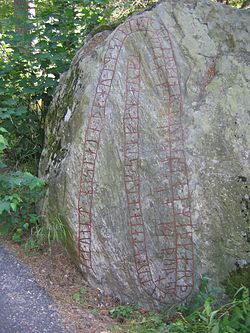Fyrby Runestone

The Fyrby Runestone, which is designated as Sö 56 in the Rundata catalog, is a Viking Age memorial runestone located in Fyrby, Södermanland, Sweden.
Description
The runic inscription on the Fyrby Runestone consists of runic text within a band that curves along the face of the stone. It is classified as being carved in runestone style RAK. The inscription is somewhat enigmatic due to its use of the pronoun "I," which may even refer to the stone itself.[1] This runestone is notable for its reference to Midgard ("Middle Earth"), one of the realms of Norse mythology.
One personal name in the inscription contains a Norse pagan god as an element of the name. Freysteinn means "Freyr's stone."[2] In addition, the Hár or "High" in the name Hásteinn, which means "high stone," may refer to a byname of the god Odin.[3]
Inscription
Transliteration of the runes into Latin characters
- iak * uait : hastain : þa : hulmstain : bryþr * menr : rynasta : a : miþkarþi : setu : stain : auk : stafa : marga eftiR * fraystain * faþur * sin *[4]

Transcription into Old Norse
- Ek veit Hástein þá Holmstein brœðr menn rýnasta á Miðgarði, settu stein ok stafa marga eptir Freystein, fôður sinn.[4]
Translation in English
- I know Hásteinn and Holmsteinn, the most rune-skilled brothers in Middle Earth, placed many a stone and staff in memory of Freysteinn, their father.[4]
References
- ^ Jesch, Judith (1998). "Still Standing in Ågersta: Textuality and Literacy in Late Viking-Age Rune Stone Inscriptions". In Hoops, Johannes; et al. (eds.). Reallexikon der Germanischen Altertumskunde. Walter de Gruyter. pp. 462–475. ISBN 3-11-015455-2.
{{cite book}}: Explicit use of et al. in:|editor-first=(help) p. 472. - ^ Grimm, Jacob (1888). Teutonic Mythology. Vol. 4. London: George Bell and Sons. p. 1355.
{{cite book}}: Unknown parameter|coauthors=ignored (|author=suggested) (help) - ^ Cleasby, Richard (1878). An Icelandic-English Dictionary. Clarendon Press. pp. 243–244.
{{cite book}}: Unknown parameter|coauthors=ignored (|author=suggested) (help) - ^ a b c Project Samnordisk Runtextdatabas Svensk - Rundata.
